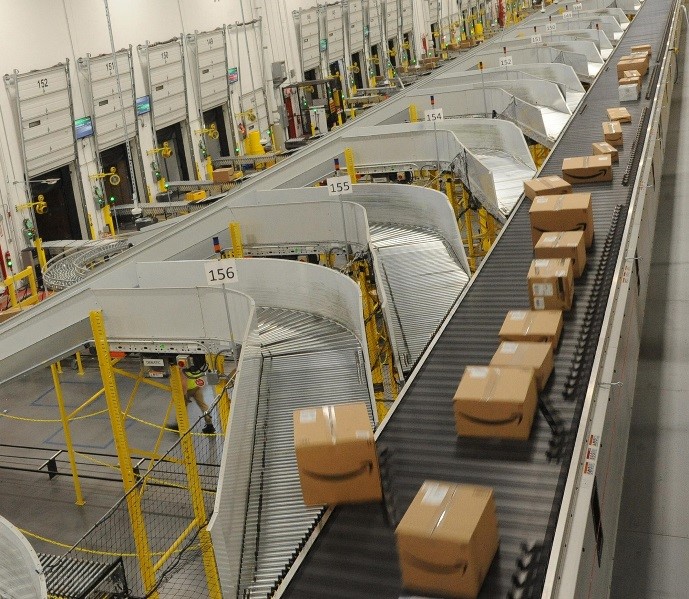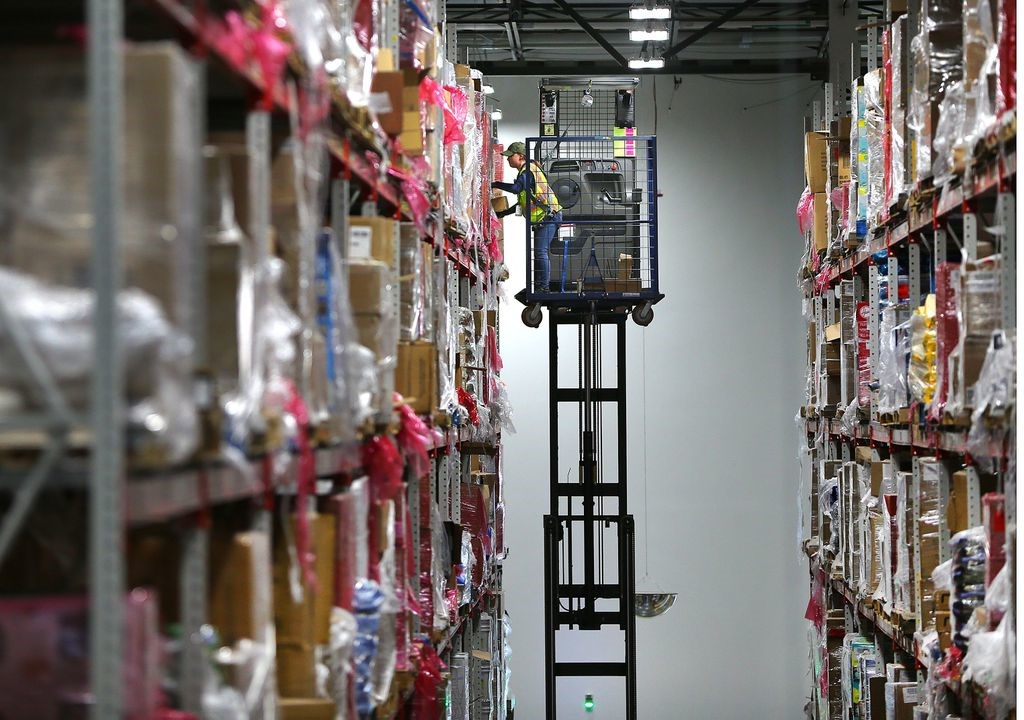Enterprise Mobility & the Connected Worker Blog
Fulfillment Center Tour Recap: Inside Amazon’s Fall River, MA Operation
by Pat Nolan | 1/24/2020
Amazon has been offering guided tours of some of its warehouse facilities and fulfillment centers for just under a year now – the anniversary of its first tour will be February 1st. The everything giant allows anyone older than the age of six to tour 25 of its 145 facilities throughout the US and 20 others internationally, as long as they book ahead of time.
This week, I took the opportunity to visit the company’s 1.7M square foot Fall River, Massachusetts fulfillment center that can comfortably house 25 football fields (Figure 1). It is the only non-sortables fulfillment center that offers these tours, although Amazon has about one non-sortables facility for every four sortables facilities overall. All “non-sortables” means is that the site handles items larger than 16 inches in any dimension that might require some extra attention throughout the fulfillment process. The Fall River location carries about 400,000 SKUs, less than a third of what an average Amazon sortables location carries, and processes about 10,000 orders a day. Those numbers include everything from mops to kayaks to pet food and diapers. Lots of diapers. They are the location’s most shipped item.
 Figure 1: Amazon’s Fall River, MA Fulfillment Center via The Boston Globe
Figure 1: Amazon’s Fall River, MA Fulfillment Center via The Boston GlobeAcross the operation’s roughly 1,200 employees – about 300 are there and working at any given time – there is a common and limited set of frontline mobile solutions. Barcodes are the de facto tracking tool and everyone has the same pistol grip scanner. Forklift operators have vehicle-mounted tablets for order picking and mobile print solutions for on-demand label requirements. There were no voice-guided solutions that seemed to be used, although I cannot say for sure. Overall, the operation is largely human-driven and straightforward – no advanced robotics or autonomous vehicles in view. About half of the employees zip back and forth on forklifts stocking or picking, and the other half do packing and loading on foot.
Still, the facility boasts some impressive technologies. Once a box is packed with all items corresponding to a given order, it is stuck with a random barcode sticker by the human packer. That barcode is then scanned to mark the box with its order information. Later placed on a conveyor belt, this box zips under a camera that scans that barcode and sends the shipping information to a printer, which the box passes under just a second or two later. In that quick moment, the scanning camera has communicated with the printer and the printer has generated a shipping label, which it slaps on the box as it rolls by.
As a box moves on to the next step in its conveyor belt journey, it is automatically processed for errors and tagged for human intervention if needed. This can happen if the original barcode was damaged – preventing the camera from reading its order information – or if its weight is off. A certain part of the belt will know if a package weighs what it is supposed to given the expected sum weight of the items in the order (every SKU is weighed and meticulously measured when first introduced to the facility) and the weight of the box itself.
Once packages are marked with shipping labels, they round a bend to the loading bay where there are about twenty or so ramps leading down to twenty or so trailers that each go to another, smaller fulfillment operation (a UPS, a DHL, etc). This last stretch of conveyer belt adjacent to the trailer ramps was impressive to watch. Each package has its new shipping label scanned and, as it passes by these ramps, horizontally-sliding nodes on the belt automatically push it down the specific ramp that leads to the appropriate trailer for its next step in the logistics process (Figure 2). Since these packages go to another fulfillment operation rather than directly to customers, this facility does not need to pack its trailers with any particular rhyme or reason other than to use space in the most efficient Tetris-like way. Although the tour covers a majority of the facility, we did avoid the inbound bay because it is uses less tech and is therefore less exciting for visitors.

Figure 2: Amazon’s Fall River Loading Bay via The Herald News
If there were a theme of the tour, it would probably be safety. Safety is prioritized far ahead of productivity and quality, our guide proclaimed at the tour’s onset, and the facility had many features to back that up. Without many robotics to worry about at this particular facility, most of these safety features are aimed at its large population of forklifts. There are separate and clearly marked “lanes” for walkers and forklifts. Where walking lanes intersect with forklift lanes, stop signs signal forklift operators to come to a complete stop where they then honk their horn as a final “LOOK OUT!” before continuing on.
Underground cables also guide forklifts throughout the facility so that drivers don’t have to worry about steering in perfectly straight lines through the tight isles of massive storage shelving units. These controlled paths keep the vehicles close to the shelves without bumping into them so that as pickers (who are harnessed in and wearing helmets) ascend up to heights of what must be at least 40 feet in their forklift cabins (Figure 3), they do not have to reach far to grab items. Lastly, each forklift beams a blue light on the floor 20 feet in front of and behind it – these are the limits on how close each operator is allowed to get to another machine.

Figure 3: Fall River Employee Picking from Forklift via The Boston Globe
As to why Amazon offers these walkthroughs, there are probably a few reasons. Firstly, the company is far from free of flak in terms of its working conditions. Stories about stressful, strained Amazon warehouse workdays are common; the transparency offered by these tours are likely meant in part to counter them, and I certainly left with a positive impression of the place. These are no doubt a recruiting tool as well. As VDC finds in its recent Modernizing the Warehouse report, the labor market for the warehousing sector is currently highly competitive and the tour showed off a clean, well-lit and comfortably temperatured potential new work environment to visitors. The guide even closed out the visit by going over Amazon’s competitive pay, continued education incentives and strong healthcare benefits – and offered an application to anyone that was interested (no takers this time around). Some attendees were simply there to observe and learn best practices to adopt for their own logistics operations. Lastly, these tours seem to more purely serve the curious mind, like a live version of How It’s Made – there were a few kids in my party with no apparent motive save to ooh and ahh at the sheer size and efficiency of the place.
For me, this tour served as a reality check. Covering enterprise technology markets, it’s easy to get caught up in the hype of the latest-and-greatest, next gen solutions of the day. Yet there I was in an Amazon fulfillment center – run by the planet’s foremost leader in the science of efficiency that has access to, and has surely helped develop, some of the most advanced logistical technologies and processes – with not a single drone, autonomous vehicle or use of advanced robotics in sight. Amazon likely employs all of those technologies and more throughout its global operation; the Fall River location, however, gave me a live glimpse at the importance of balancing tech implementations of any magnitude with a strong frontline workforce and a thoughtful use of space and non-technical operational elements for the most effective outcome.
For more in-depth coverage on warehousing operations and the mobile technologies that fuel their frontline workers, download the executive brief to VDC’s Modernizing the Warehouse report here, or reach out to info@vdcresearch.com to connect about our related coverage.